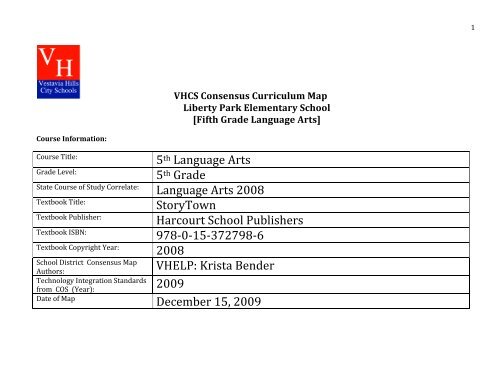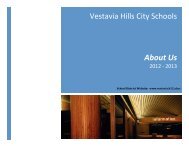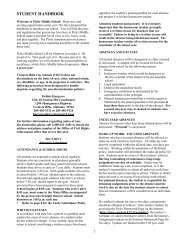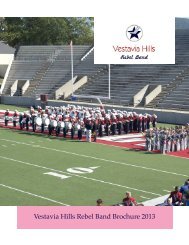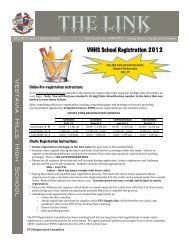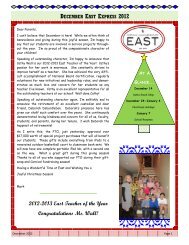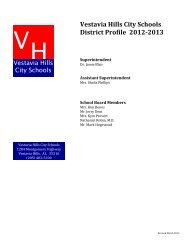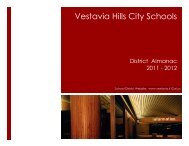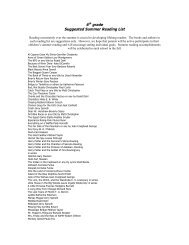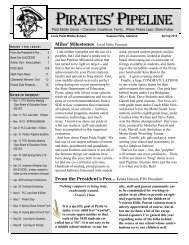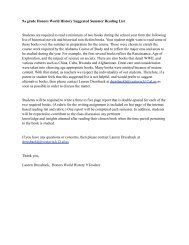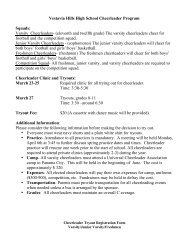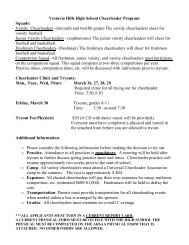5th Language Arts 5th Grade Language Arts 2008 StoryTown ...
5th Language Arts 5th Grade Language Arts 2008 StoryTown ...
5th Language Arts 5th Grade Language Arts 2008 StoryTown ...
Create successful ePaper yourself
Turn your PDF publications into a flip-book with our unique Google optimized e-Paper software.
1 VHCS Consensus Curriculum Map Liberty Park Elementary School [Fifth <strong>Grade</strong> <strong>Language</strong> <strong>Arts</strong>] Course Information: Course Title: <strong>Grade</strong> Level: State Course of Study Correlate: Textbook Title: Textbook Publisher: Textbook ISBN: Textbook Copyright Year: School District Consensus Map Authors: Technology Integration Standards from COS (Year): Date of Map 5 th <strong>Language</strong> <strong>Arts</strong> 5 th <strong>Grade</strong> <strong>Language</strong> <strong>Arts</strong> <strong>2008</strong> <strong>StoryTown</strong> Harcourt School Publishers 978-‐0-‐15-‐372798-‐6 <strong>2008</strong> VHELP: Krista Bender 2009 December 15, 2009
2 Vocabulary Writing Process Fiction Text Reader's Theatre Literary Elements Non[iction Texts <strong>Language</strong> <strong>Arts</strong> Poetry Grammar Descriptive Writing Expository Writing Narrative Writing
3 Vocabulary Word Chunks Root Word In[lected Endings Context Clues Pre[ixes Suf[ixes Words in Context Sentence Structure Multiple Meaning Words
4 Nouns Parts of Speech Verbs Adjectives Grammar Subject/Verb Agreement Compound sentences Sentence Structure Double Negatives Conjuctions Homonym Word Analysis Homophone Homograph Punctuation Daily Oral <strong>Language</strong> Verb Tense Writing Mechanics
5 Reader's Theatre Voice Intonation Presentation/ Role Play Eye Contact Articulation Eye Contact Listening Skills Meaning in Text
6 Text Features Research Current Resources Non[iction Texts Facts and Opinions Biographies Genres Autobiographies Historical Fiction Rereading Self Monitor Comprehension Use Prior knowledge Skimming through text Persuasive Author's Purpose Entertaining Informing
7 Main Idea Details Summarize Sequence of Events Fiction Texts Lit Circle Lit Log Preview Predicting Prior Knowledge Lit Circle Lit Log Theme Character's Traits Character's Motives Plot Con[lict/Resolution Setting
8 Brainstorming Prewriting Graphic Organizers Writing Process Outlining Organization Rough Draft Get Ideas on Paper Word Choice/Vivid <strong>Language</strong> Main Idea -‐ What does not belong? Revising/Editing Sentence Structure Precise Vocabulary Clarity Publish
9 Expository/ Persuasive Writing Introduction/Main Idea Three Supportive Reasons/Explanations/ Steps Organization Concluding Paragraph Transitions Purpose/Audience Tone
11 Descriptive Writing Introductory Paragraph Detail Paragraph Organization Concluding Paragraph Transtitions Sensory Details Vivid <strong>Language</strong> Use Figurative Langauge Appropriate Tone Audience/ Purpose Writing matches mode
12 Literary Elements Theme Character Traits Persausive Writing Sub-‐Topic Sub-‐Topic Figurative <strong>Language</strong> Sub-‐Topic Sub-‐Topic Main Idea/ Details Sub-‐Topic
13 Metaphors Personi[ication Poetry Figurative <strong>Language</strong> Similes Onomatopeoia Alliteration Hyperbole Voice Intonation Presentation Eye Contact Articulation
14 Poetry Essential Questions How can Idevelop anappreciation ofpoetry? Content Skills Assessments Lessons Standards Recognize use ofliterary elementsto gaininformation(metaphors,personification) Demonstratereadingvocabularyknowledge. Identify impliedpurpose Recognizepersuasivetechniques 1.1 – Demonstrate reading vocabularyknowledge, including recognition ofmultiple-meaning words. 1.3.3 ~ Recognizing use ofpersonification 3.8.3 ~ Utilizing precise vocabulary inoral and written presentations 3.9.1 ~ Using quotation marks withtitles of short stories and poems 3.10.2 ~ Identifying homonyms,homophones, and homographs Demonstrate eyecontact,articulation andappropriate voiceintonation withpresentations 5.12 ~ Demonstrate eye contact,articulation, and appropriate voiceintonation with expositorypresentations. 5.12.1 ~ Using dramatizations withoral persuasive presentations 5.12.2 ~ Using figurative languagefound in literature to enhance oralcommunication
15 5.13 ~ Apply strategies of a skillfullistener, including maintaining eyecontact, attending to the listening task,and assigning meaning to themessage. DescriptiveWriting Essential Questions What isdescriptivewriting? Content Skills Assessments Lessons Standards Determinepurpose andaudience beforewriting.Demonstrateclarity andorganization in acomposition.Use appropriateprewritingstrategies.Composedescriptive textusing anintroductoryparagraph,1.2.3 ~ Distinguishing fiction andnonfiction 1.3 ~ Recognize the use and effect ofliterary elements and devices,including setting, character traits,stated purpose, metaphors, andsimple symbolism to gain informationfrom various text formats, includingtables and charts. 3.7.1 ~ Determining purpose andaudience prior to writingaudienceówriter uses appropriate tone 3.7.2 ~ Demonstrating clarity andorganization in a composition
16 sensory details,vivd languageand conclusion. 3.7.4 ~ Using appropriate prewritingstrategies 3.7.7 ~ Composing descriptive textsusing an introductory paragraph,sensory details, vivid language, and aconclusion 3.8.1 ~ Editing writing for clarity ofthought 3.8.3 ~ Utilizing precise vocabulary inoral and written presentations 3.9 ~ Apply mechanics in writing,including capitalization of first word ina direct quotation and use ofpunctuation, including quotationmarks and comma with directquotations, colon to introduce a list,and commas after introductory words,with a noun of direct address, and in acompound sentence. 3.9.3 ~ Using apostrophes withpossessives 3.10 ~ Demonstrate knowledge ofgrammar and usage concepts,including subject-verb agreement witha compound subject; present, past,and future verb tenses; forms ofadjectives; forms of nouns; andsubject, object, and possessivepronouns.
17 pronouns. 3.10.1 ~ Writing sentences without theuse of double negatives 3.10.3 ~ Using irregular verbs inwriting 3.10.4 ~ Using adjectives, adverbs,conjunctions, nouns, and verbs inwriting 3.10.5 ~ Demonstrating correct use ofprepositions and interjections HistoricalFiction Essential Questions How do events inhistorical fictionrelate to eventsin history? Content Skills Assessments Lessons Standards DemonstratereadingcomprehensionCompare genrecharacteristics ofhistorical fiction1.1 ~ Demonstrate reading vocabularyknowledge, including recognition ofmultiple-meaning words. 1.1 ~ Demonstrate reading vocabularyknowledge, including recognition ofmultiple-meaning words. MonitorComprehensionUse self1.2.3 ~ Distinguishing fiction andnonfiction
18 monitoring fortextunderstandingUse previewingand predicting todeterminecontent.1.4 ~ Use a wide range of strategiesand skills, including using textfeatures to gain meaning,summarizing passages, and drawingconclusions, to comprehend fifthgradeinformational and functionalreading materials. 1.4.4 ~ Using previewing andpredicting skills to determine content 1.4.7 ~ Using self-monitoring for textunderstanding2.5 ~ Compare the genrecharacteristics of autobiographies,biographies, and historical fiction,including multicultural literature. DescriptiveWriting -continued Essential Questions Can I write adescriptive paperfrom a prompt? Content Skills Assessments Lessons Standards Composedescriptive textusing anintroductoryparagraph,sensory details,vivid language3.7.7 ~ Composing descriptive textsusing an introductory paragraph,sensory details, vivid language, and aconclusion 3.8.2 ~ Correcting awkward sentenceconstruction, redundancy, fragments,and run-ons in written presentations
19 and conclusion and run-ons in written presentations 3.8.3 ~ Utilizing precise vocabulary inoral and written presentations 3.10 ~ Demonstrate knowledge ofgrammar and usage concepts,including subject-verb agreement witha compound subject; present, past,and future verb tenses; forms ofadjectives; forms of nouns; andsubject, object, and possessivepronouns. 3.10.4 ~ Using adjectives, adverbs,conjunctions, nouns, and verbs inwriting 3.10.5 ~ Demonstrating correct use ofprepositions and interjections NarrativeWriting Essential Questions What is narrativewriting? Content Skills Assessments Lessons Standards Composenarrative textsusing a definitetime frame, aclear sequenceof events, and a3.7.2 ~ Demonstrating clarity andorganization in a composition 3.7.3 ~ Using appropriate transitionwords in a composition
20 selected tone.Use appropriatetransitions wordsin a composition.Edit writing forclarity ofthoughts. 3.7.6 ~ Composing narrative textsusing a definite time frame, a clearsequence of events, and a selectedtone 3.8.1 ~ Editing writing for clarity ofthought 3.9 ~ Apply mechanics in writing,including capitalization of first word ina direct quotation and use ofpunctuation, including quotationmarks and comma with directquotations, colon to introduce a list,and commas after introductory words,with a noun of direct address, and in acompound sentence. 3.10.3 ~ Using irregular verbs inwriting TECH COS #1: Use input and output devices of technology systems. TSW use correct keyboarding techniques to type their writing using Microsoft Word. Biography Essential Questions What is theimpact of otherContent Skills Assessments Lessons Standards Use priorknowledge to1.2 ~ Use a range of strategies,including drawing conclusions such as
21 people's lives onour culture. interpretmeaning.Skim passagesto understandsignificance.Monitorcomprehension. opinions about characters based ontheir actions and summarizingpassages, to comprehend fifth-graderecreational reading materials in avariety of genres. 1.2.5 ~ Using prior knowledge andexperience to interpret meaning 1.4.7 ~ Using self-monitoring for textunderstanding1.4.10 ~ Skimming passages to getsignificance of passage 2.5 ~ Compare the genrecharacteristics of autobiographies,biographies, and historical fiction,including multicultural literature. TECH COS #8: Collect information from a variety of digital sources. TSW evaluate whether a source is reliable or not. NonFictionEuropeanExploreres Essential Questions Content Skills Assessments Lessons Standards How does Use text features 1.2 ~ Use a range of strategies,
22 learning about past cultures help us understand the world today? to guideinterpretation.Use researchstrategies in theresearch processto identifyreliableresourcesSkim passagesto understandsignificance including drawing conclusions such asopinions about characters based ontheir actions and summarizingpassages, to comprehend fifth-graderecreational reading materials in avariety of genres. 1.2.3 ~ Distinguishing fiction andnonfiction 1.2.6 ~ Skimming passages to obtainprimary message 1.3 ~ Recognize the use and effect ofliterary elements and devices,including setting, character traits,stated purpose, metaphors, andsimple symbolism to gain informationfrom various text formats, includingtables and charts. 1.4.3 ~ Distinguishing fact fromopinion 1.4.6 ~ Using prior knowledge andexperience to interpret meaning 1.4.10 ~ Skimming passages to getsignificance of passage 1.4.11 ~ Using reference materials 2.6 ~ Use text features, includingindexes, tables, and appendixes, toguide interpretation of expositorytexts.
23 guide interpretation of expositorytexts. Fiction LitCircles Essential Questions How can applycomprehensionstrategies to myreading? Content Skills Assessments Lessons Standards Identify word"chucks".Recognizeliterary devices.Compare andcontrast toextend meaning.Determine causeand effect. 1.1 ~ Demonstrate reading vocabularyknowledge, including recognition ofmultiple-meaning words. 1.1 ~ Demonstrate reading vocabularyknowledge, including recognition ofmultiple-meaning words. 1.1.1 ~ Identifying word ìchunksî orparts 1.2.1 ~ Determining sequence ofevents in recreational readingmaterials 1.2.2 ~ Comparing and contrasting toextend meaning 1.2.7 ~ Inferring motive of characters 1.3 ~ Recognize the use and effect ofliterary elements and devices,including setting, character traits,stated purpose, metaphors, andsimple symbolism to gain informationfrom various text formats, including
24 stated purpose, metaphors, andsimple symbolism to gain informationfrom various text formats, includingtables and charts. 1.3.2 ~ Identifying main idea andsupporting details 1.4.1 ~ Determining sequence ofevents1.4.2 ~ Determining cause and effect 1.4.7 ~ Using self-monitoring for textunderstandingNarrativeWritingcontinued Essential Questions Can I write anarrative paperfrom a prompt? Content Skills Assessments Lessons Standards Composenarrative textsusing a definitetime frame, aclear sequenceof events, and aselected tone. 3.7.2 ~ Demonstrating clarity andorganization in a composition 3.7.6 ~ Composing narrative textsusing a definite time frame, a clearsequence of events, and a selectedtone Apply mechanicsin writing
25 in writing 3.9 ~ Apply mechanics in writing,including capitalization of first word ina direct quotation and use ofpunctuation, including quotationmarks and comma with directquotations, colon to introduce a list,and commas after introductory words,with a noun of direct address, and in acompound sentence. ExpositoryWriting Essential Questions What isexpositorywriting? Content Skills Assessments Lessons Standards Composepersuasive texts,including aminimum of threereasons thatsupport a stanceor position.Demonstrateknowledge ofgrammar andusage concepts.3.7 ~ Compose expository texts usingan introductory paragraph thatincludes a main idea; supportingparagraphs with a minimum of threereasons, explanations, or steps in aprocess; and a conclusion. 3.7.1 ~ Determining purpose andaudience prior to writingaudienceówriter uses appropriate tone 3.7.3 ~ Using appropriate transitionwords in a composition Composeexpository texts. 3.7.5 ~ Composing persuasive texts,including a minimum of three reasonsthat support a stance or position
26 expository texts. 3.8 ~ Express meaning throughwriting varied sentence structure,detailed paragraphs, and multiparagraphcompositions in anorganized manner. 3.8.2 ~ Correcting awkward sentenceconstruction, redundancy, fragments,and run-ons in written presentations 3.10 ~ Demonstrate knowledge ofgrammar and usage concepts,including subject-verb agreement witha compound subject; present, past,and future verb tenses; forms ofadjectives; forms of nouns; andsubject, object, and possessivepronouns. 3.10.3 ~ Using irregular verbs inwriting NonFiction Essential Questions What type of information can I gather by reading nonfiction texts? Content Skills Assessments Lessons Standards Recognizepersuasivetechniques.Use sentence1.1.2 ~ Recognizing inflected endings 1.2.3 ~ Distinguishing fiction andnonfiction
27 structure andcontext todeterminemeaning.Recognizeinflected ending1.2.4 ~ Using sentence structure andcontext to determine meaning 1.2.5 ~ Using prior knowledge andexperience to interpret meaning 1.3.1 ~ Recognizing persuasivetechniques 1.3.4 ~ Identifying implied purpose 1.4 ~ Use a wide range of strategiesand skills, including using textfeatures to gain meaning,summarizing passages, and drawingconclusions, to comprehend fifthgradeinformational and functionalreading materials. 1.4.6 ~ Using prior knowledge andexperience to interpret meaning 1.4.9 ~ Recognizing persuasivetechniques 2.6 ~ Use text features, includingindexes, tables, and appendixes, toguide interpretation of expositorytexts.
28 ExpositoryWritingcontinued Essential Questions How can writinghelp mecommunicate myfeelings andexpress mycreativity? Content Skills Assessments Lessons Standards Express meaningthrough writingvariedsentences. 3.7 ~ Compose expository texts usingan introductory paragraph thatincludes a main idea; supportingparagraphs with a minimum of threereasons, explanations, or steps in aprocess; and a conclusion. 3.7.3 ~ Using appropriate transitionwords in a composition 3.8.2 ~ Correcting awkward sentenceconstruction, redundancy, fragments,and run-ons in written presentations 3.9 ~ Apply mechanics in writing,including capitalization of first word ina direct quotation and use ofpunctuation, including quotationmarks and comma with directquotations, colon to introduce a list,and commas after introductory words,with a noun of direct address, and in acompound sentence.
29 Fiction LitCircles Essential Questions How can I applycomprehensionstrategies to myreading? Content Skills Assessments Lessons Standards Determinesequence ofeventsInfer motive ofcharactersIdentify impliedpurpose 1.2.1 ~ Determining sequence ofevents in recreational readingmaterials 1.2.7 ~ Inferring motive of characters 1.3.4 ~ Identifying implied purpose ReviewModes ofWriting Essential Questions How can I use avariety of writingstyles? Content Skills Assessments Lessons Standards Apply mechanicsin writingCapitalize propernouns andadjective.3.7 ~ Compose expository texts usingan introductory paragraph thatincludes a main idea; supportingparagraphs with a minimum of threereasons, explanations, or steps in aprocess; and a conclusion. Use apostropheswith possessives Express meaningthrough writingvariedsentences.3.7.1 ~ Determining purpose andaudience prior to writingaudienceówriter uses appropriate tone
30 through writingvariedsentences.Demonstrateknowledge ofgrammar whenwriting in allmodes of writing. 3.7.2 ~ Demonstrating clarity andorganization in a composition 3.7.3 ~ Using appropriate transitionwords in a composition 3.7.4 ~ Using appropriate prewritingstrategies 3.7.5 ~ Composing persuasive texts,including a minimum of three reasonsthat support a stance or position 3.7.6 ~ Composing narrative textsusing a definite time frame, a clearsequence of events, and a selectedtone 3.7.7 ~ Composing descriptive textsusing an introductory paragraph,sensory details, vivid language, and aconclusion 3.8 ~ Express meaning throughwriting varied sentence structure,detailed paragraphs, and multiparagraphcompositions in anorganized manner. 3.8.1 ~ Editing writing for clarity ofthought 3.8.2 ~ Correcting awkward sentenceconstruction, redundancy, fragments,and run-ons in written presentations
31 and run-ons in written presentations 3.8.3 ~ Utilizing precise vocabulary inoral and written presentations 3.9 ~ Apply mechanics in writing,including capitalization of first word ina direct quotation and use ofpunctuation, including quotationmarks and comma with directquotations, colon to introduce a list,and commas after introductory words,with a noun of direct address, and in acompound sentence. 3.9.2 ~ Capitalizing proper adjectives,titles of books, and works of art 3.9.3 ~ Using apostrophes withpossessives 3.10 ~ Demonstrate knowledge ofgrammar and usage concepts,including subject-verb agreement witha compound subject; present, past,and future verb tenses; forms ofadjectives; forms of nouns; andsubject, object, and possessivepronouns. 3.10.4 ~ Using adjectives, adverbs,conjunctions, nouns, and verbs inwriting
32 3.10.5 ~ Demonstrating correct use ofprepositions and interjections HistoricalFictionJean FritzColonialBiographies Essential Questions How do events in historical fiction relate to actual history? Content Skills Assessments Lessons Standards Determine causeand effect. Distinguish factfrom opinion. Demonstrate eyecontact,articulation andappropriate voiceintonation withpresentations 1.2 ~ Use a range of strategies,including drawing conclusions such asopinions about characters based ontheir actions and summarizingpassages, to comprehend fifth-graderecreational reading materials in avariety of genres. 1.4.2 ~ Determining cause and effect 1.4.3 ~ Distinguishing fact fromopinion 5.12 ~ Demonstrate eye contact,articulation, and appropriate voiceintonation with expositorypresentations.
33 Fiction LitCircles Essential Questions Why ispunctuationimportant? Content Skills Assessments Lessons Standards Identify main ideaand supportingdetails1.1 ~ Demonstrate reading vocabularyknowledge, including recognition ofmultiple-meaning words. Use text featuresto comprehend fifthgrade readingmaterials.Demonstratereadingvocabulary/multiplemeaning words.Respond in writingto open-endedquestions.Use apostrophesappropriately.1.1 ~ Demonstrate reading vocabularyknowledge, including recognition ofmultiple-meaning words. 1.1.3 ~ Identifying possessives andcontractions 1.3.2 ~ Identifying main idea andsupporting details 2.6 ~ Use text features, includingindexes, tables, and appendixes, toguide interpretation of expository texts. 3.8.5 ~ Responding in writing to openendedquestions 3.9.1 ~ Using quotation marks with titlesof short stories and poems 3.9.3 ~ Using apostrophes withpossessives
34 Biography Essential Questions How do I useinformation inbooks and othersources to writereports? Content Skills Assessments Lessons Standards Compare genrecharacteristics.Use referencematerials1.2.6 ~ Skimming passages to obtainprimary message 1.4.10 ~ Skimming passages to getsignificance of passage Skim passagesto obtain primarymessage 1.4.11 ~ Using reference materials 2.5 ~ Compare the genrecharacteristics of autobiographies,biographies, and historical fiction,including multicultural literature. Fiction LitCircles Essential Questions Why should I beable to identifydifferent genresin literature? Content Skills Assessments Lessons Standards Distinguishfiction andnonfictionUse text featuresto gain meaningDrawconclusionsabout characters 1.2.3 ~ Distinguishing fiction andnonfiction 1.2.7 ~ Inferring motive of characters 1.3 ~ Recognize the use and effect ofliterary elements and devices,including setting, character traits,stated purpose, metaphors, andsimple symbolism to gain informationfrom various text formats, including
35 conclusionsabout characters stated purpose, metaphors, andsimple symbolism to gain informationfrom various text formats, includingtables and charts. 1.4 ~ Use a wide range of strategiesand skills, including using textfeatures to gain meaning,summarizing passages, and drawingconclusions, to comprehend fifthgradeinformational and functionalreading materials. 1.4.7 ~ Using self-monitoring for textunderstanding2.6 ~ Use text features, includingindexes, tables, and appendixes, toguide interpretation of expositorytexts.
36 SUPPLEMENTAL TEXTBOOKS: Writers Express: A Handbook for Young Writers, Thinkers, and Learners by Dave Kemper PRINT RESOURCES: Literature Circle Chapter books: The Last Holiday Concert, Frindle, School Story, Lunch Money. The Report Card, Extra Credit, Thigns Not Hoped For, Things not Seen, Things that are, Landry’s News: by Andrew Clements Bridge to Terabithia by Katharine Paterson The Sign of the Beaver by Elizabeth George Speare Tuck Everlasting by Natalie Babbit The Watsons Go to Birmingham by Christopher Paul Curtis Al Capone Does My Shirts by Gennifer Choldenko How to Steal a Dog by Barbara O’Connor Shakespear’s Secret by Elise Broach Stargirl by Jerry Spinelli The Mixed-‐Up Files of Mrs. Basil E. Frankweiler by E.L. Konigsburg The Westing Game by Ellen Raskin Hatchet, Tracker, Brian’s Winter, The Island, Brian’s Return, The River: By Gary Paulsen Because of Winn Dixie by Kate DiCamillo Experenza Rising by Pam Munoz Ryan The Shadow Children Series by Maragaret Peterson Haddix Emily’s Runaway Imagination, Socks, Ramona and Her Father, Ribsy, The Mouse and the Motorcycle, Ruanaway Ralph, Ralph S. Mouse, Dear Mr. Henshaw by Beverly Clearly ONLINE RESOURCES: Renaissance Place (Accelerated Reader): http://hosted239.renlearn.com/74910
37 STATE AND LOCAL STANDARDS: Reading: 1. Demonstrate reading vocabulary knowledge, including recognition of multiple-‐meaning words. -‐ Identifying word “chunks” or parts -‐ Recognizing inflected endings -‐ Identifying possessives and contractions 2. Use a range of strategies, including drawing conclusions such as opinions about characters based on their actions and summarizing passages, to comprehend fifth-‐grade recreational reading materials in a variety of genres. -‐ Determining sequence of events in recreational reading materials -‐ Comparing and Contrasting to extend meaning -‐ Using sentence structure and context to determine meaning -‐ Using prior knowledge and experience to interpret meaning -‐ Skimming passages to obtain primary message -‐ Inferring motive of characters. 3. Recognize the use and effect of literary elements and devices, including setting, character traits, stated purpose, metaphors, and simple symbolism to gain information from various text formats, including tables and charts. -‐ Recognizing persuasive techniques -‐ Identifying main idea and supporting details -‐ Recognizing use of personification -‐ Identifying implied purpose 4. Use a wide range of strategies and skills, including using text features to gain meaning, summarizing passages, and drawing conclusions, to comprehend fifth-‐grade informational and functional reading materials. -‐ Determining sequence of events -‐ Determining cause and effect -‐ Distinguishing fact from opinion -‐Using previewing and predicting skills to determine content -‐ Using sentence structure and context to determine word meaning -‐ Using prior knowledge and experience to interpret meaning -‐ Using self-‐monitoring for text understanding -‐ Using expanded vocabulary to determine word meaning -‐ Recognizing persuasive techniques
38 -‐ Skimming passages to understand significance of passage -‐ Using reference materials. Literature: 5. Compare genre characteristics of autobiographies, biographies, and historical fiction, including multicultural literature. 6. Use text features, including indexes, tables, and appendixes, to guide interpretation of expository texts. Writing and <strong>Language</strong>: 7. Compose expository texts using an introductory paragraph that includes main idea; supporting paragraphs with a minimum of three reasons, explanations, or steps in a process; and a conclusion. -‐ Determining purpose and audience prior to writing -‐ Demonstrating clarity and organization in a composition -‐ Using appropriate transition words in a composition -‐ Using appropriate prewriting strategies -‐ Composing persuasive texts, including a minimum of three reasons that support a stance or position -‐ Composing narrative texts using a definite time frame, a clear sequence of events, and a selected tone. -‐ Composing descriptive texts using an introductory paragraph, sensory details, vivid language, and a conclusion 8. Express meaning through writing varied sentence structure, detailed paragraphs, and multi-‐paragraph compositions in an organized manner. -‐ Editing writing for clarity of thought -‐ Correcting awkward sentence construction, redundancy, fragments, and run-‐ons in written presentations -‐ Utilizing precise vocabulary in oral and written presentations -‐ Bulleting major details and ideas to support a topic or subject -‐ Responding in writing to open-‐ended questions 9. Apply mechanics in writing, including capitalization of first word in a direct quotation and use of punctuation, including quotation marks and comma with direct quotations, colon to introduce a list, and commas after introductory words, with a noun of direct address, and in a compound sentence. -‐ Using quotation marks with titles of short stories and poems -‐ Capitalizing proper adjectives, titles of books, and works of art -‐ Using apostrophes with possessives 10. Demonstrate knowledge of grammar and usage concepts, including subject-‐verb agreement with a compound subject; present, past, and future tenses; forms of adjectives; forms of nouns; and subject, object, and possessive pronouns.
39 -‐ Writing sentences with out the use of double negatives -‐ Identifying homonyms, homophones, and homographs -‐ Using irregular verbs in writing -‐ Using adjectives, adverbs, conjunctions, nouns, and verbs in writing. -‐ Demonstrating correct use of prepositions and interjections. Research and Inquiry: 11. Use search strategies in the research process to identify reliable current resources and computer technology to locate information. Oral and Visual Communication 12. Demonstrate eye contact, articulation, and appropriate voice intonation with expository presentations. -‐ Using dramatizations with oral persuasive presentations -‐ Using figurative language found in literature to enhance oral communication. 13. Apply strategies of a skillful listener, including maintaining eye contact, attending to the listening task, and assigning meaning to the message.


